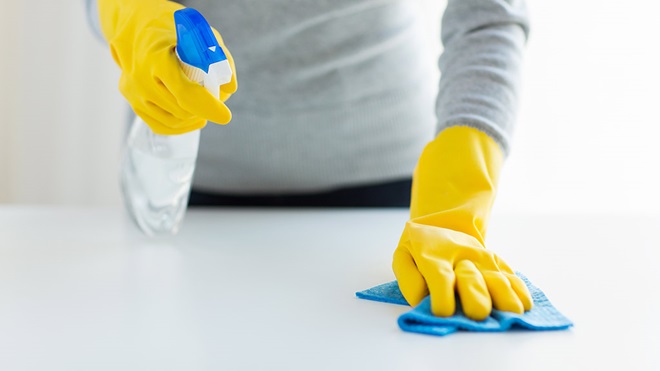Whether you're doing a full spring clean or a quick whip around to spot-clean some daily messes, the job is made much easier with an effective surface cleaner. Here's how our experts determine the best multipurpose cleaners on the market, including floor cleaners, bathroom cleaners and toilet cleaners.
On this page:
- Our expert testers
- How we choose which products we test
- How we test multipurpose cleaners
- How we test bathroom cleaners
- How we test toilet cleaners
- How we test floor cleaners
Our expert testers
Although we have our own NATA-accredited laboratories at CHOICE, when it comes to surface cleaners we send a range of products available from major supermarkets to an external laboratory for testing. We also work out the value for money of each product by calculating the cost per 100mL or measuring how much detergent comes out with each pump of the trigger.
How we choose which products we test
With a range of surface cleaners on the market, what makes us choose one to test over another? As with most of our product testing, our aim is to test the most brands on the market and what you're most likely to see in stores.
We check stores to see what's available across the range of products, and from this information we put together a final list that goes to our buyers. They then head out to the retailers and purchase each product, just as a regular consumer would. We do this so we can be sure what we buy is the same as any consumer would find it and not 'tweaked' in any way for better performance.
How we test multipurpose cleaners
Lab experts put each cleaner to the test using pre-soiled melamine tiles. Using a scrubbing apparatus with a sponge attached, the sheet is then scrubbed 40 times. The reflectance readings are taken before and after cleaning to determine how much dirt the cleaners remove.
Scoring
For surface cleaners, dirt removal accounts for 100% of the CHOICE Expert Rating, our overall score that determines which products we recommend.
For glass cleaners, the CHOICE Expert Rating is made up of dirt removal (50%) and a streak test (50%). The streak test is a visual assessment whereby each product is rated based on how many streaks and/or drops are left behind. The test is carried out three times and the results are averaged.
How we test bathroom cleaners
We test a range of spray, foam and gel type bathroom cleaners as well as bathroom cleaning wipes. We've also tested refill concentrates as well as tablets, powders and pods that are mixed or dissolvable in water for application as a spray.
To determine which bathroom cleaners are best, the testing lab measures soap scum removal and follows the manufacturer's instructions for application times.
The soiled test tiles are sourced from the Centre for Test Materials and the soil is a new, realistic looking soap scum that's been developed specifically for evaluating the performance of bathroom cleaners. The bathroom cleaner is applied directly to the tile using a spray applicator. After the product has been left to sit (according to the manufacturer's instructions), it is scrubbed through 10 scrub cycles in the scrub tester and rinsed under a gentle stream of water. The tiles are then allowed to air dry.
Using a spectrophotometer the tiles are scanned prior to testing and then again after scrubbing and drying. These values are then used to calculate the percentage of soil removal.
Scoring
Soap scum removal accounts for 100% of the CHOICE Expert Rating for bathroom cleaners.
How we test toilet cleaners
Lab experts put each toilet cleaner to the test by soiling white ceramic tiles with a NASA specification faecal test soil.
The tiles are allowed to dry, squirted with a measured dose of toilet cleaner, and then scrubbed using a sponge mounted to a mechanical scrubbing apparatus.
We ensure each tile receives exactly the same number of scrubs at the same speed and pressure.
The reflectance of the tiles is measured before and after cleaning using a sensitive photospectrometer to determine how much soil is removed, and then this data is converted to a score to get the CHOICE Expert Rating.
Scoring
Soil removal accounts for 100% of the CHOICE Expert Rating for toilet cleaners.
How we test floor cleaners
Our floor cleaners test covers general floor cleaning/disinfecting products, not carpet cleaners or products specified for wooden floors. Lab experts put each floor cleaner to the test by soiling white ceramic tiles with oily grime. Using a scrubbing apparatus with a damp cloth (or wipe) attached, the tiles are then scrubbed 20 times.
The reflectance readings are measured before and after cleaning to determine how well each product removes dirt, so you can find out which ones will do the best job on your floors at home.
Scoring
Dirt removal accounts for 100% of the CHOICE Expert Rating for floor cleaners.
We're on your side
For more than 60 years, we've been making a difference for Australian consumers. In that time, we've never taken ads or sponsorship.
Instead we're funded by members who value expert reviews and independent product testing.
With no self-interest behind our advice, you don't just buy smarter, you get the answers that you need.
You know without hesitation what's safe for you and your family. And our recent sunscreens test showed just how important it is to keep business claims in check.
So you'll never be alone when something goes wrong or a business treats you unfairly.
Learn more about CHOICE membership today
Stock images: Getty, unless otherwise stated.



